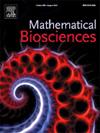在小叶原位癌(LCIS)简化模型中,细胞内聚缺陷与小叶定位有关。
IF 1.8
4区 数学
Q2 BIOLOGY
引用次数: 0
摘要
小叶原位癌(LCIS)是乳腺浸润性小叶癌的前兆。由于e -钙粘蛋白的缺失,LCIS细胞缺乏细胞间的凝聚力。LCIS细胞生长在乳腺小叶而不是乳腺导管中。这种模式的病因,特别是它对细胞内聚的依赖,还不完全清楚。我们在超简化的中空模组织复制品(HMTR)和离散时间数学模型中模拟了原位癌(CIS)细胞的被动腺内散射,该模型具有代表单个细胞(lcis样颗粒)或内聚癌细胞群(dcis样颗粒)的可变大小颗粒。HMTR的结构类似于乳腺导管和相关小叶。离散数学模型表征了随时间的空间再分布,并包括导管或小叶定位之间的转移概率。粒子的重新分布取决于粒子的大小,趋向于一种平衡。引人注目的是,平衡比例取决于粒子的性质,我们也在考虑控制小叶性质(如拥挤)的连续时间数学模型中证实了这一点。颗粒的大小越来越大,代表CIS细胞具有熟练的凝聚力,显示出越来越高的平衡导管比例。我们的研究代表了两个概念抽象,暗示了细胞-细胞内聚丧失和LCIS小叶定位之间的联系,这为研究乳腺组织中集体细胞行为与癌症发展之间的联系提供了急需的逻辑基础。根据我们简化建模方法的发现,我们讨论了近期研究的多种途径,可以在数学和经验上解决和评估再分配假设。本文章由计算机程序翻译,如有差异,请以英文原文为准。
Deficient cell-cell cohesion is linked with lobular localization in simplified models of lobular carcinoma in situ (LCIS)
Lobular carcinoma in situ (LCIS) is a precursor of invasive lobular carcinoma of the breast. LCIS cells lack cell-cell cohesion due to the loss of E-cadherin. LCIS cells grow in mammary lobules rather than in ducts. The etiology of this pattern, especially its dependence on cellular cohesion, is incompletely understood. We simulated passive intra-glandular scattering of carcinoma in situ (CIS) cells in an ultra-simplified hollow mold tissue replica (HMTR) and a discrete-time mathematical model featuring particles of variable sizes representing single cells (LCIS-like particles) or groups of cohesive carcinoma cells (DCIS-like particles). The HMTR features structures reminiscent of a mammary duct with associated lobules. The discrete mathematical model characterizes spatial redistribution over time and includes transition probabilities between ductal or lobular localizations. Redistribution of particles converged toward an equilibrium depending on particle size. Strikingly, equilibrium proportions depended on particle properties, which we also confirm in a continuous-time mathematical model that considers controlling lobular properties such as crowding. Particles of increasing size, representing CIS cells with proficient cohesion, showed increasingly higher equilibrium ductal proportions. Our investigations represent two conceptual abstractions implying a link between loss of cell-cell cohesion and lobular localization of LCIS, which provide a much-needed logical foundation for studying the connections between collective cell behavior and cancer development in breast tissues. In light of the findings from our simplified modeling approach, we discuss multiple avenues for near-future research that can address and evaluate the redistribution hypothesis mathematically and empirically.
求助全文
通过发布文献求助,成功后即可免费获取论文全文。
去求助
来源期刊

Mathematical Biosciences
生物-生物学
CiteScore
7.50
自引率
2.30%
发文量
67
审稿时长
18 days
期刊介绍:
Mathematical Biosciences publishes work providing new concepts or new understanding of biological systems using mathematical models, or methodological articles likely to find application to multiple biological systems. Papers are expected to present a major research finding of broad significance for the biological sciences, or mathematical biology. Mathematical Biosciences welcomes original research articles, letters, reviews and perspectives.
 求助内容:
求助内容: 应助结果提醒方式:
应助结果提醒方式:


